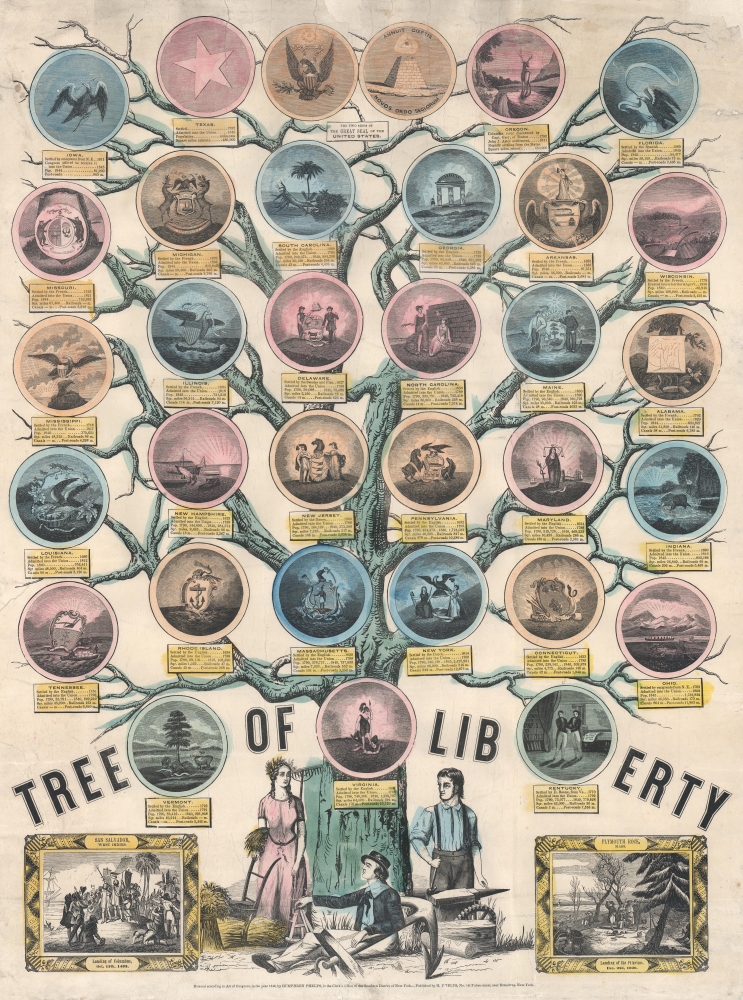This item has been sold, but you can get on the Waitlist to be notified if another example becomes available, or purchase a digital scan.
1846 Phelps 'Tree of Liberty' Patriotic Broadside
TreeofLiberty-phelps-1846
Title
1846 (dated) 27.5 x 21 in (69.85 x 53.34 cm)
Description
A Closer Look
Statistics relating to each state, including when it was first settled, when it was admitted to the Union, its population in 1790 and 1840, and the miles of railroads, post-roads, and canals within its borders, appear below each medallion. Three young arborists collectively represent American economy. One is a farmer, holding a plow and a bushel of wheat. Another is a blacksmith with hammer and anvil. The third is a sailor, seated next to the tree's trunk, resting on a ship's anchor, and holding a sextant. Two vignettes occupy the lower corners. On the left is a view of the landing of Christopher Columbus in San Salvador. On the right, a view presents the arrival of the Pilgrims at Plymouth Rock.The Tree of Liberty
The expression 'Tree of Liberty' harkens to a letter written by Thomas Jefferson to William S. Smith, a diplomatic official in London, on November 13, 1787. The full quote reads,What signify a few lives lost in a century or two? The tree of liberty must be refreshed from time to time with the blood of patriots and tyrants. It is its natural manure…The letter concerned Daniel Shays' 1786-1787 rebellion in Massachusetts. While Jefferson did not support the underlying causes of the Shays Rebellion, he did support the rebellion itself as a proper expression of men's natural rights to overthrow an unjust system. The letter is a window into just how fiery Jefferson's own political thinking had become. In modern times, the 'Tree of Liberty' has taken on darker meanings and is often associated with terrorist and political fringe groups. Timothy McVeigh, the Oklahoma City Bomber, wore a tee-shirt emblazoned with a bloody 'Tree of Liberty' in 1995 and in 2009 William Kostric carried a sign reading 'Time to water the tree of liberty' when he carried a semi-automatic handgun to President Obama's Town Hall Meeting in Portsmouth, New Hampshire.
Publication History and Census
This broadside was created and published by Humphrey Phelps in 1846. We note three OCLC examples: New-York Historical Society, the American Antiquarian Society, and Williams College. An additional example is located at the Amon Carter Museum of American Art in Fort Worth, Texas. In 1846, Ensign and Thayer published their own edition of this Tree of Liberty broadside. Phelps worked closely with both Ensign and Thayer, so it is likely that both editions were printed from the same plate.Cartographer
Humphrey Phelps (1799 - 1875) was an American map, broadside, and book publisher based in New York City. Phelps was born in 1799 in Hebron, Connecticut. Phelps' earliest work seems to be a plan of New York City for his Stranger's Guide, dating to about 1830. Between 183- and 1837 he published with Bela Scovil Squire (1786 - 1861) under the imprint of Phelps and Squire. The New York map publishing circle seems to have been quite close and Phelps commonly partnered with various other New York publishers and printers including Edward H. Ensign (1818 - 1871), Horace Thayer, Erastus Clark Bridgman (1817 - 1870), Thomas C. Fanning (1805 - 1873), Hooker, Peabody, Charles Magnus, Gaylord Watson, and George Walker, among others. The natural consequence of his rampant partnering is a vast and varied corpus of work including many scarce items with low print runs. Phelps is best known for his emigrant and tourist guides. More by this mapmaker...

